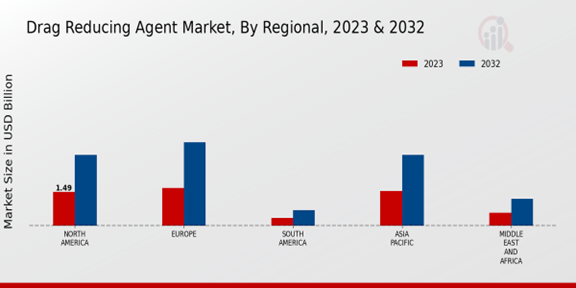Market Growth Projections
The Global Drag Reducing Agent Market Industry is poised for substantial growth, with projections indicating a market size of 6.59 USD Billion in 2024 and an anticipated increase to 16.5 USD Billion by 2035. This growth trajectory suggests a compound annual growth rate of 8.67% from 2025 to 2035. Such figures underscore the increasing reliance on drag reducing agents across various sectors, particularly in oil and gas, where efficiency and cost-effectiveness are paramount. The market's expansion reflects broader trends in industrial optimization and sustainability, indicating a robust future for drag reducing agents.
Increasing Oil and Gas Production Activities
The Global Drag Reducing Agent Market Industry is significantly influenced by the increasing activities in oil and gas production. As exploration and extraction efforts intensify, the need for efficient transportation of hydrocarbons becomes paramount. Drag reducing agents facilitate smoother flow in pipelines, thereby minimizing energy consumption and enhancing overall productivity. This trend is particularly evident in regions with high oil production, where the adoption of drag reducing agents is becoming standard practice. The market's growth trajectory is expected to align with the rising production levels, further solidifying its importance in the energy sector.
Rising Awareness of Cost-Effective Solutions
There is a growing awareness among industries regarding the cost-effective benefits of using drag reducing agents, which is shaping the Global Drag Reducing Agent Market Industry. Companies are increasingly recognizing that these agents not only improve flow efficiency but also lead to substantial savings in operational costs. By reducing friction in pipelines, drag reducing agents can lower energy consumption and maintenance expenses. This realization is prompting more industries to adopt these solutions, thereby driving market growth. As organizations strive for profitability while maintaining operational efficiency, the demand for drag reducing agents is likely to rise, contributing to the overall expansion of the market.
Regulatory Support for Environmental Sustainability
Regulatory frameworks across various regions are increasingly favoring environmentally sustainable practices, which significantly impacts the Global Drag Reducing Agent Market Industry. Governments are implementing stringent regulations aimed at reducing greenhouse gas emissions and promoting energy efficiency. For instance, the introduction of policies that encourage the use of drag reducing agents in pipelines aligns with these sustainability goals. This regulatory support not only fosters innovation but also incentivizes companies to adopt drag reducing technologies. As a result, the market is expected to grow, with projections indicating a potential increase to 16.5 USD Billion by 2035, driven by compliance with environmental standards.
Technological Advancements in Chemical Formulations
Innovations in chemical formulations are playing a pivotal role in shaping the Global Drag Reducing Agent Market Industry. Advances in polymer science and nanotechnology are leading to the development of more effective drag reducing agents that can operate efficiently under various conditions. These technological improvements not only enhance performance but also broaden the application scope of drag reducing agents in different sectors, including oil and gas, water treatment, and chemical processing. As companies invest in research and development, the market is likely to experience a compound annual growth rate of 8.67% from 2025 to 2035, reflecting the positive impact of these advancements.
Growing Demand for Efficient Transportation Solutions
The Global Drag Reducing Agent Market Industry is witnessing a surge in demand driven by the need for efficient transportation solutions. As global trade expands, the transportation of crude oil and refined products becomes increasingly critical. Drag reducing agents enhance flow characteristics, thereby reducing energy consumption and operational costs. In 2024, the market is projected to reach 6.59 USD Billion, reflecting the industry's response to the rising demand for efficient logistics. This trend is likely to continue as companies seek to optimize their supply chains and reduce carbon footprints, suggesting a robust growth trajectory for drag reducing agents.






















